#pollinator: robin
Text
The Beauty of Spring is a Wonderful Thing to See
The Beauty of Spring is a Wonderful Thing to See shows readers several signs that spring has come to central Florida. These signs includes several types of flowers, American robins, and carpenter ants pollinating some of the flowers.
Spring Glow
Spring has definitely arrived here in central Florida. The trees are putting out little green sprouts that will soon be full grown leaves. The grass is beginning to green up again, and flowers are beginning to bloom. Despite what the groundhog predicted, the robins (Turdus migratorius), my spring forecaster, predicted an early spring around here. They began forming large flocks and…

View On WordPress
#American robins#Carolina cherry laurels#Carolina jessamine#carpenter ants#Eastern redbud#photography#spring#spring birds#spring in Florida#spring insects#spring pollinators#spring wildflowers#springtime#springtime photographs#springtime photography#wild radishes
0 notes
Text
some times i see people talking about the Earth and climate change saying things like "now i know it is difficult to deal with utter hopelessness, terror, and visiting the thoughts of death"
and it's like wow I am so deeply sorry about the suffering. but...concern. Concern. Tell me, am I missing something important? Why do I feel a sense of hope for our planet? Am I a lonely fool? Have I been consumed by naïveté and misguided optimism?
That would be weird. It feels weird. It feels like I would be well suited to despair. My natural temperament is Mortal Terror making my body crushed for a thousand years at the bottom of the deepest trenches of the ocean. I've thought before "I can't live any more. This exceeds the tensile strength of the human spirit."
And then? After irreversible catastrophic failure of the soul, there is...what?
We try to imagine the future where we fight to save our home and it is very painful. The resistance feels so small and the machine of death feels so vast. But something's missing.
Everyone else is missing—the plants, trees, bugs, beasts, and creatures. Hello? Are the other humans seeing this? Nature wants you to know that she is not a princess in a tower. Look! Look at the chaos moving through every cell! Iterating! Adapting! Becoming! Thriving! Watch the pollinators tirelessly at work, observe the mycorrhizal network in the forest floor distributing the rich fruits of decay and photosynthesis for every inhabitant! Pay attention! We belong here too. They feed and shelter us, give us the very air we breathe, and in return we plant and propagate, cull, thin, and burn, shape, trample, till, shepherd and sprout seeds. Our species can look toward the future, to the world of our descendants. We can call every plant and animal by name and teach our children to use and care for them responsibly. We can feel this anger, pain, and grief on behalf of the family of Life, OUR family, and we can love the smallest beetle and the humblest moss.
Look at it! This thing is nothing like me, it does not benefit me, it has no use or purpose for me, but LOOK at it! Look at its intricate structure! Look at the marvelousness of its behaviors and biological functions! Look at its uniqueness throughout the whole universe! Look at it, and see its infinite value!
I saved a baby tree from the scorching hot gravel of a parking lot. I watched it grow and thrive in the hands of its caretaker. Many more followed, trees and herbs and flowers, rescued and carefully placed in cups and old tubs that once held yogurt and sour cream. This is so strange, I thought. They're everywhere, offering themselves for free, and no one thinks to take them. Everyone thinks transplanting a tree is hard and that nothing grows on the edge of the pavement but weeds. But it's so easy??? This is weird. Plant Nurseries Hate Her: Get Free Plants With This One Weird Trick.
I protected an old barren garden patch where nothing had thrived from being mowed and weed-whacked, and transplanted little plants that I found. I marveled at the bees that came. Chicory bloomed, then asters and goldenrod. I shed actual tears over a spicebush swallowtail. I ordered some milkweed from the internet, and the monarchs came for them. Less then twenty-five bucks for a divine experience like this. Wow, everyone else really needs to know!
I started volunteering at a nature center, and was allowed to transplant flowers where they sprouted in inopportune locations. I collected tons of seeds all fall and winter long.
There is much, much more, all of it bigger than I ever would have imagined. But this spring there were more birds, in number and in species, than I'd ever seen in my back yard before. Chickadees, swallows, finches, nuthatches, jays, cardinals, warblers, sparrows, woodpeckers of every kind...I remembered just a couple years prior when all I ever saw out there was a couple grackles or starlings or robins, with the occasional sparrow. Those birds come in flocks rather than couples now. And then the bumblebee arrived. An American bumblebee, endangered now, a queen. For a few days she was always out there, would fly out and buzz around me when I came out to tend to my now-innumerable plants. It's nesting time for them. She chose this place I was creating. She saw that this place would take care of her.
A week ago, I discovered wild strawberries growing in my Mamaw's driveway. I found lyreleaf sage growing beside a gravel road. I've become a master of transplanting; I took several of each home. Yesterday, I saw a tiny, metallic blue bee, an Osmia mason bee. Today, I saw an oriole and a strange, very fancy fly. I see something new almost every day. Every day I am being irreversibly changed as a person. How did I ever fail to see how much this matters?
I said I feel hope...do I feel it? I don't think it's a feeling, I think it's a practice. It's being part of our communities and our ecosystems. Nature's interconnectedness is both reality and example: to survive, we take care of one another. And when one member of the community helps another thrive, it creates a cascade that increases the thriving of all. Just by existing, you help us all survive.
You can only take care of so many plants before you have to give some away. You can only hold so much knowledge before you have to give it away. I gave seeds to a dozen different flowers to my next-door neighbor and she invited me inside and wouldn't let me leave without food, and we talked about plants and trees. A family friend lets me have goats' milk and heirloom vegetables in exchange for help around the farm, and I listen to him talk about trees, bugs, and soil and learn so much I feel like I'm about to explode from knowledge.
Being a caretaker is unavoidably a community-oriented, community-forming thing. You can't grow plants all by yourself. Your garden will make too many tomatoes. Share them. Your milkweed will make hundreds and hundreds of seeds. Spread them. Wild blackberries invite you to take and eat. Your lonely retired neighbor invites you to talk and keep her company. Once you grow delicious fruits or little oak trees, you always have a reason to greet someone and say, "Look, it is a gift!"
We're not alone. We are not separate. We take care of each other. Every species, every individual. A single action of caretaking creates a cascade effect of thriving. A single unapologetic love for a creature creates a blossom of curiosity and fascination in everyone surrounding. It's so powerful.
As my chemical romance says "I am not afraid to keep on living"
#nature#community#plants#gardening#you are not separate from every other thing#the wonders#caretaking#plantarchy
2K notes
·
View notes
Text
Note to new foragers;
while you are learning about the species you want to harvest, also learn what sustainable harvesting looks like. Learn about invasive species management, and agroecology. A lot of people start with the book Braiding Sweetgrass, by Dr Robin Wall Kimmerer. It is approachable, and covers the Honorable Harvest really well. The Poor Proles Almanac podcast and Substack are both incredible sources of information as well.
In general, tho, you should start by knowing this:
- If a species is native, and especially if it is rare on the landscape, do what you can to encourage it. Don’t over harvest, clear away invasives around it, save and spread its seeds. Maybe even hand pollinate it if needed.
- If a species is not native, feel free to harvest much more of it. Discourage its spread, but you don’t necessarily need to remove every single one you see. For a very small select few non native species, a little bit of spreading can even be okay. But be sure you know what you are doing. In general, it is better to remove a non native species than to let it stay. Keep native seeds on you to replace them with. I carry around little dime bags of seeds.
- if a species is Invasive (not native & choking out native species) remove as much as you can without damaging the local ecology. For foraging this might mean you harvest a ton of yellow charlock, even more than you need, because you see it choking out wild lettuce. This is a good thing to do (at least where I am). Because the charlock will overtake everything. But if you start managing in other ways, like tarping or tilling or spraying, keep in mind that oftentimes the medicine can be worse than the disease. If you spray a field of charlock you don’t get wild lettuce, you get more charlock.
Anyways, good luck!
413 notes
·
View notes
Note
I'm guessing that as a graduate student you have read a zillion and one documents and books and papers and things in your field. Would it be outrageous to ask for recommendations/your favorites? I'm really interested in learning more about the history of Native land use and food systems in the midwest (which I suppose is a very long history, I'd be happy learning about any time period), prairie ecology, and the current outlook for native plants and pollinators (and conservation recommendations). Even one recc for each would be amazing. Feel free to postpone this ask if you're too busy! P.S. can't wait to read your dissertation.
This is a big ask, and I get a lot of these types of asks! In the future it'd be nice if people were more specific about their interests and not asking about general, huge topics. There's a level that you can and should be googling yourself! Many academic papers are online for free through sites like academia.edu and I'm not a search engine!
General answer if you're interested in this range of topics is Robin Wall Kimmerer's Braiding Sweetgrass. She comes from the midwest and writes some on prairie and the book is all about Indigenous science stewardship.
Otherwise, the topics you're asking for don't have one single source that will tell you everything you're looking for. People make small studies of one community, one ecosystem, one plant. Whether it's ecology or ethnobotany, there's no one making compendiums of info, especially not in the midwest. That's why I do the work I do, but even what I do is imperfect. Be suspicious of anyone who/any text that claims to be comprehensive on a huge, complex subjects; they probably are bsing you.
Indigenous Land Mgmt:
Two good recent papers:
The subject of indigenous wild management is more intensely covered in California (M. Kat Anderson) and Vancouver (Nancy J. Turner). Those two authors are great for both nuts and bolts chat and philosophical perspectives about how people have lived in and altered and restored their ecosystems.
A compelling academic book on the subject is Roots of Our Renewal:
Ethnobotany and Cherokee Environmental Governance by Clint Carroll, which is just as much about philosophy, knowledge production and protection and community building, as plants.
Prairie Conservation Practices:
Like I said above, currently published stuff is about very specific interactions and focuses, like a particular pollinator group in a particular plant. What you're looking for, a generalist summary of the field, doesn't really exist.
If you're looking for plant lists and how-tos Tallgrass Restoration Handbook or the Tallgrass Prairie Center Guide. Do not go for Ben Voigt. If you're looking for a general conceptual entry to Midwest conservation/restoration, there's Ecological Restoration in the Midwest
If you're looking for general recommendations for free, Xerces.org is the resource for bee-friendly landscaping and planting.
If you live near a University or Arboretum or Botanic Garden, this is the kind of thing where you should just browse the shelves near the books I've recommended! Chances are you have free access to the libraries, if not the ability to check the books out yourself!
#this is imperfect but it took 40 minutes just to put this together#please be considerate of people's time#long post
189 notes
·
View notes
Text
Numbers snapshot -
Signups have been open for 5 days, so it's time for another numbers snapshot. We have 385 creators signed up offering 536 auctions in 218 fandoms - 104 listed, and 114 write-ins. Which fandom will be the biggest write-in fandom of 2024?
At the top of the write-in list are:
5 Yu Yu Hakusho
4 The Stanley Parable
4 Tortall
3 Ace Attorney
3 Bungo Stray Dogs
3 Danny Phantom
3 Dragon Ball
3 For All Mankind
3 Realm of the Elderlings - Robin Hobb
3 The Goblin Emperor Series - Katherine Addison
(A list of the other write-in fandoms will be posted later today with additional deets, so stay tuned.)
And the leaderboard for the listed fandoms looks like this:
67 K-Pop *
50 Good Omens
35 Sherlock Holmes *
31 Harry Potter *
26 Red, White, & Royal Blue
25 Marvel *
25 Mo Dao Zu Shi / The Untamed
21 DC *
18 Scum Villain's Self-Saving System
18 Star Wars *
16 Teen Wolf
14 Locked Tomb Trilogy
14 Supernatural
Additionally 69 creators are offering to work in ANY fandom.
Among our supported orgs, 'bidder's choice' unsurprisingly tops the list, followed by MECA, Sherlock's Homes, NAA, and In Our Own Voice. Orgs that could use more love include Together Bay Area, Deploy/Us, Wildlands Restoration Volunteers, Pollinator Partnership, and Bellingcat.
In types of fanwork, creators are offering:
357 written fanworks
63 fan art
57 fan labor
33 podfics
6 videos
7 other digital fanwork
Fan labor includes 12 offers for translation in various combinations of:
Catalan
English
Filippino
French
German
Spanish
Vietmanese
and some limited assistance in Russian.
(A post with a breakdown of additional fan labor offerings also coming soon!)
Signups are OPEN!
38 notes
·
View notes
Text
Oakie the Acorn is the Best Mascot Ever
I don’t even go to this school I just love them. Here’s an interview they did for SUNY Mascot Madness.
Oakie - SUNY ESF
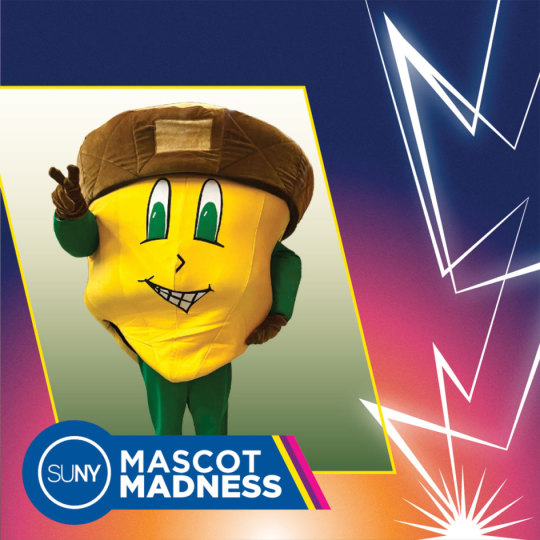
Who are you, where are you originally from, and where do you do your mascot thing?
I'm Oakie Acorn (they/them), proud representative of ESF and its Mighty Oaks athletic teams! I was “born” when I fell out of ESF's Robin Hood Oak which means my roots go back to the Major Oak in England's Sherwood Forest. Maybe that's why I'm so merry! While most of my mascot duties have me in Syracuse, I also pop in at our Ranger School in Wanakena and our satellite campuses in the Adirondacks and Thousand Islands.
What's a unique new thing (building, club, activity, employee, etc.) on your campus that you treasure?
The newly renovated Marshall Hall is wonderful! Open since 1933, Marshall underwent a major two-year reno re-opening in 2023. We kept the classic features, such as the spiral staircase and auditorium, while updating the building to a state-of-the-art learning center with spaces tailored to the needs of today's students. The building is home to our Landscape Architecture, Environmental Studies, and mathematics programs.
Along with great classroom and studio space, there are plenty of study nooks for students to tuck in and do work between classes or meet with friends.
If you could start your own club or major on campus, what would it be?
Wow! Difficult question because ESF has so many unique clubs, activities, and majors already! That said, I'd love to start an a capella group – Oak-apella! I don't speak, but I have a song in my heart and would love to hear ESF students sing. Maybe I could do some interpretive dance while they sing.
What's your hidden talent that you haven't told anyone about yet?
Anyone on campus at night might have seen me skateboarding. The other day I landed a kickflip over the gap and was pretty stoked. Sadly, no one was around to see it. Flicks or it didn't happen, right? We do have some talented campus artists who have drawn me and my board though.
What campus cheer gets you pumped up and why?
(with great enthusiasm)
O-A-K-I-E!
They're our acorn can't you see?
Sprouting strong through day and night
We've got bark and we've got bite!
ESF Orientation Leaders chant this while they lead our newest acorns to convocation. I love hearing it echo off the campus buildings!
What sport would you play if you were a student-athlete?
I would join the Bass Fishing team in a heartbeat! I know when you think “acorn,” you think “land-based,” but I'd love to get out on the water and drop a line or two. There's so much more to me than most people know.
I would look awesome in one of the Bass Fishing team jerseys – provided they could get me an XXXXXL.
Read any good books lately?
The Climate Optimists Handbook by environmental activist Anne Therese Gennari is a great read. Her book is about empowering people to get excited about changing the narrative on climate change so we act from courage and excitement to co-create a better world. She totally gets the ESF vibe! She was our commencement speaker last May and inspired our graduates and their guests to Improve Our World!
And of course, Braiding Sweetgrass by our own Dr. Robin Wall Kimmerer is always close at hand to read again and again!
Favorite pizza topping?
Mushrooms. I love to top my pie with things I've foraged in the woods. Remember, you have to be very careful with mushrooms. I always take along a friend who has taken Dr. Alex Weir's mycology course to ensure I don't eat anything that could make me sick or worse!
If you were SUNY Chancellor for a day, what would you do?
I would declare every day Earth Day in SUNY and plant pollinator gardens on every campus. I would also help other campuses set and reach their own Zero-Waste goals. Sustainability is a key component to helping the environment. I would then ask to be Chancellor for a couple more days to visit as many campuses as possible and see all the great things SUNY students are doing. I don't know how Chancellor King does it all! Does he ever sleep?
How would you celebrate being named SUNY Mascot Madness Champion in 2024?
The same way I celebrated in 2017 when I won the title – surrounded by the best students, faculty, and staff ever! We had a party that the whole campus attended. My friend, Victor E. Knight from SUNY Geneseo, was gracious enough to come and present me with the trophy and join the festivities. I think it would be great to host Wolfie on campus this year.
#oakie the acorn#SUNYESF#mascot#mascotmadness#queer#nonbinary#acorn#theySKATEBOARD#voteforOakie#environment#climate change#poll bracket
16 notes
·
View notes
Text
Personality Ratings Of The Birds That Visit My Bird Feeders
I have the beginnings of a little bird/pollinator garden outside of my bedroom window. It's nothing to show off yet, but I have a pretty big variety of regulars. And, like any bartender, I've come to silently judge them all from afar. Here are my ratings of my local Seed Bastards:
Dark-Eyed Junco:
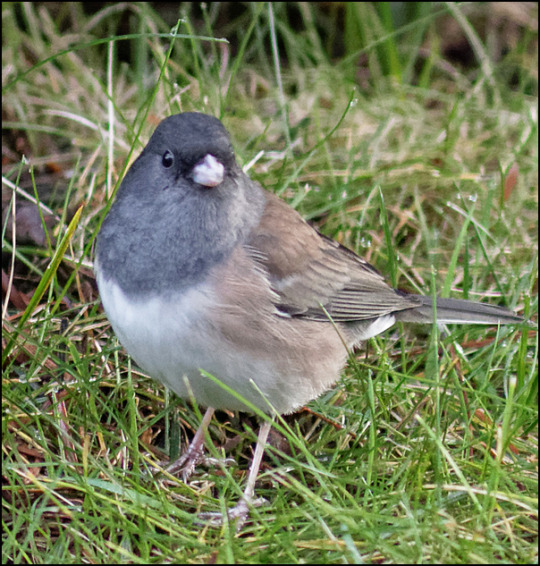
Bastard Rating: 4/10 They take no shit and don't mind continuing to eat within about 10' of me when I'm actively working outside. Mostly bogart the feeders through numbers rather than actual bastardy. They go berserk for sunflower seeds and shelled peanuts. Don't scare easy but also aren't terribly interested in getting into it with the other birds.
House Finch:
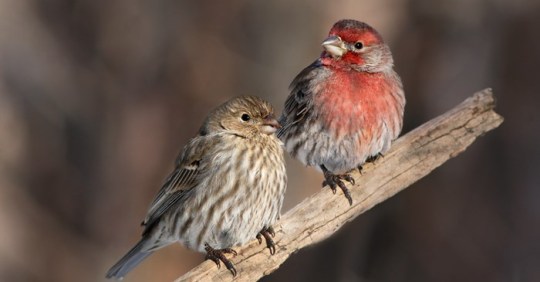
Bastard Rating: 7/10 Refuses to share feeders. Chases other birds except their wives from the feeders, and will fully "nest" on tray feeders so their fat asses block the other birds from getting any from the feeder. I vaguely suspect they're racist toward the other birds because they'll only allow other house finches to eat from the feeders they're squatting in. At the same time, I've seen males feeding other males. Possible problematic queer icons. More review needed.
Chestnut-Backed Chickadee:

Bastard Rating: 5/10 Too tiny to really pose much of a territorial issue, but kinda remind me of flying chihuahuas. They mind their own business when they can, but will not hesitate to throw hands with other birds over either the sunflower feeder or suet cake. Generally don't hold grudges and stay in their lanes, until it comes to suet cakes.
Golden-Crowned Sparrow:

Bastard Rating: 2/10 Hang out in pretty big numbers, but otherwise mind their own business and eat when the other birds aren't taking up the feeders. They prefer the ground feeders. They're generally pretty chill. Their only true crimes are their systematic massacres of my supplies of black oil sunflower seeds.
Varied Thrush:

Bastard Rating: 0/10 Competes with Spotted Towhees in terms of raw cunt-serving power, both my cat and I get all kinds of tingly when this thot shows up. Yeah, he knows you're staring. He knows how good he looks. He's the flashiest bitch on the block. Robins? Dowdy Catholic school kids. Goldfinches? All color, no drama. This magnificent slut is here to slay.
Spotted Towhee:

Bastard Rating: 4/10 The hot goth vampire kid in high school you're 99% has their own OF account. Professionally Round. Uses his phat ass to own the runway (and my feeders) next to his frumpy competition. Is secretly a complete nerd. Basically if Laszlo Cravensworth was a bird.
Pine Siskin:
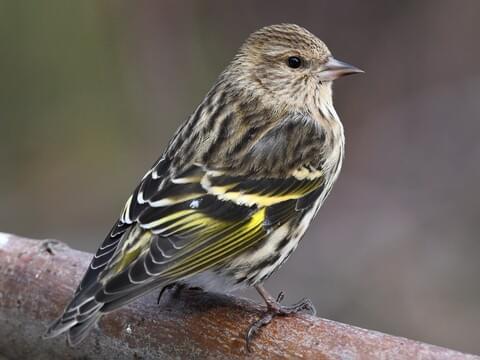
Bastard Rating: 9/10 This barely-there wannabe-goldfinch would apply lube to the bottom of your heels on Drag Night. The Heelies of the bird world; never truly cool but grasping at any legitimacy he can get. Nobody appreciates plagiarism. And ugh, he couldn't even be bothered to finish blending. What a rank slag. Get off my stage and learn how to work, bitch.
Black-Capped Chickadee:
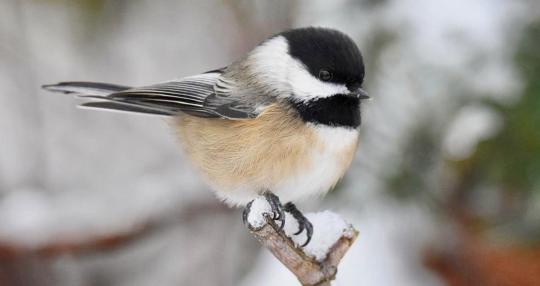
Bastard Rating: 11/10 DO NOT BE DECEIVED BY THEIR ROUND CUTENESS. These little fuckers are the gangbangers of the forest. Subsist on raw suet cake and spite. They're consistently possessed with the rage of a lust-addled Klingon woman. What the fuck are you doing at their suet cake? God help you, if you're at their suet cake, they will c u t y o u.
Song Sparrow:

Bastard Rating: -1/10 Babygirl. Precious. Just wants to sit on the edge of the gutters or the top of the feeders and make it as independent folk singers. Probably resort to posting hole from time to time to make end's meet. Always eat last because it's all love, my brothers in Christ.
Anna's Hummingbird:
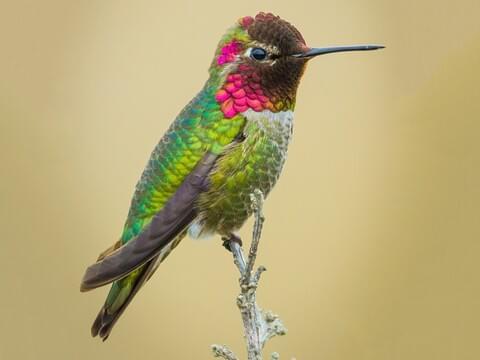
Bastard Rating: 9/10 While they may have cool optical illusions when it comes to their holographic feathers, they verbally abuse me every time I refill the feeder and it hurts my feelings :(
Rufous Hummingbird:
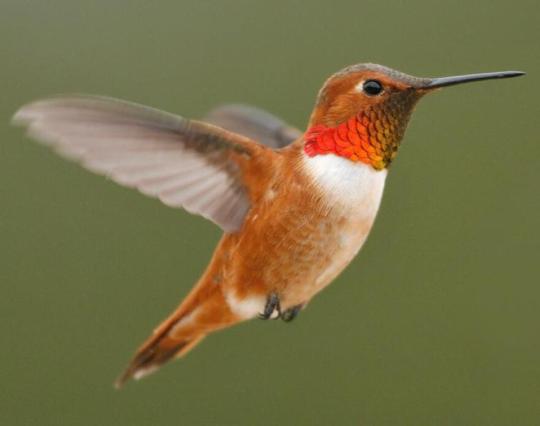
Bastard Rating: 1/10 Shy bois. They stay out of the way until they're sure I've gone back inside before they'll visit the feeders. Generally loners.
Ruby-Throated Hummingbird:
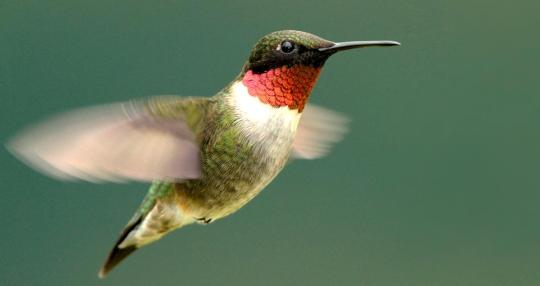
Bastard Rating: 3/10 Generally the It Girls of the bird world. You know your garden is officially making it when these start showing up. They know they're the most popular but generally try to stay grounded about it. Will sometimes hang out and chat while the hummingbird feeder is being refilled. Used to scare me as a kid because my sister convinced me they'd try to stab their beaks into acne spots. While untrue, they don't have much of a sense of personal space.
Mourning Dove:

Bastard Rating: 1/10 Generally only bother the other birds because they're fat and eat in groups big enough to make it hard for the other birds to get at the seed on the ground. Sing beautifully. Makes Hatoful Boyfriend kind of make sense. Ngl kinda wanna befriend one. Confuse me a little bit whenever I see them because I live in a swamp and didn't expect to find any doves out here.
Stellar's goddamned Jay:
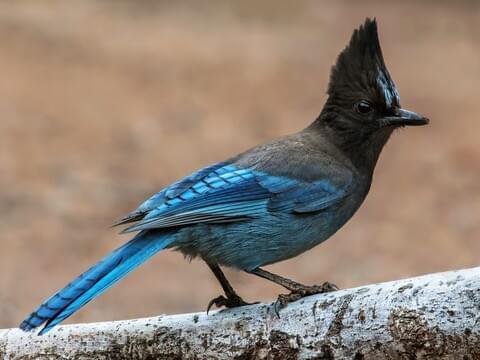
Bastard Rating: WHAT DO I HAVE TO DO?!/FUCK I KNOW THE SUNFLOWER DISPENSER JIGGLES WHEN YOU TRY TO FLY YOUR FAT ASS INTO IT. NO, I CANNOT MAKE THE FEEDER POLE STOP WIGGLING WHEN YOU PARK YOUR WIDE LOAD ON TOP OF IT. GDI I BOUGHT PEANUTS FOR YOU. STOP IMITATING A SHRIEKING HAWK TO SCARE AWAY THE OTHER BIRDS AND LEARN TO SHARE YOU ABSOLUTE TWAT.
15 notes
·
View notes
Text
The Adeia - a modern festival to Demeter

Historically, it’s often during times of hardships and crisis that new cults would be established and religious innovations would appear. This one is no different. It’s through discussion with @iliosflower that the idea of creating a new festival, one that would more accurately respond to modern problematics, came to fruition. This is what we’d like to explain in this post and hope that the idea finds an echo, and hopefully, validation from the wider community.
Why? What is it supposed to do?
On a global scale, we’re dealing with a climate crisis that is putting food sources at risk. On a more local level, conflicts and abnormal weather are creating risks of bad harvests, resources shortages and/or inflations.
We are aware that not everyone is impacted directly by the current ongoing issues, but we hope that this festival (or at least the idea) can be useful beyond these and be seen through a wider scope of praying for food security at large.
We named the festival Adeia, from the ancient Greek ἄδεια, which conveniently can signify both “abundance”/”plenty” and “freedom from fear”/”security”. All things the festival aims for.
How? What would the festival entail?
For whom? Demeter Soteira (the saviour) and Herakles Alexikakos (averter of evil). While this is what we thought was appropriate, we gladly encourage additions, especially if it fits your local situation (eg. Poseidon or Zeus could both make logical additions to protect from droughts or other natural disasters that impact food security).
For what? An answer to the needs of current events; fear of food shortages/wheat shortages
Purpose; invoke the Saviour and Averter of Evil, ask for their continued blessings for plentiful food in the home for you and your loved ones, thanking them for past blessings, ask them to watch over those that will be hit the hardest by the current food crisis. Ask for Herakles’ strength and forbearance in the coming year; ask for Demeter’s continued blessing of your home’s stores.
Date: 1st weekend of September (2022: 3-4th of September) / a week before Eleusinian Mysteries. These dates are based on the Northern hemisphere, feel free to make the dates match your local harvest calendar.
Ideal food offerings:
Pig; preferably piglet (if findable); fat and smoke to go up to Demeter; BBQ will do perfectly.
Rye, barley, and wheat as grains (if rice/corn or another grain is the majority grain in your area, go for that instead), baked into cakes, and/or tossed on the fire for Demeter.
Some kind of honey fritters; honey and bees are connected to Demeter, as a thank you for their pollinating the plants, flowers, and all that grows; or fruits and vegetables; to honour the “fruit of Demeter’s labour” and all she does for mankind.
Ideal drink offerings;
Grain-based drinks (see: Kykeon at her festival in Eleusis); you can get close to this with beer, mead, with a mint flavouring preferably.
Other ideas to offer;
Donate either food/money to your local food banks or charities that help in relief from food shortages.
Support local farmers/buy your groceries for this weekend solely from regional products.
Bring awareness to the current crisis and see what you can do to support others.
Make a votive offering and give it to Demeter and/or Herakles on this date.
Read the Hymn to Demeter out loud/listen to a recording of it, as a reminder of her blessings to mankind and how she relieved us from famine before.
A simple libation and prayer of thanks goes a long way; offering what you can afford/can do in your situation is historically attested and perfectly valid. Offerings should be made according to what is possible and reasonable for your means.
Feedback, discussion & questions welcome.
Sources used in the making of the festival;
Hesiod, Works and Days
Pindar, Olympian XIII
A Companion to Food in the Ancient World, Nadeau, Robin Wilkins, John
Earthquakes and the Gods: Reflections on Graeco-Roman Responses to Catastrophic Events, Fritz Graf
Demeter, Myths, and the Polyvalence of Festivals, Sarah Iles Johnston
#hellenic polytheism#hellenic religion#hellenic pagan#hellenic paganism#hellenic deities#helpol#theoi#demeter#demeterdeity#demeter deity#hellenic pantheon#hellenic prayer
362 notes
·
View notes
Text

Laurent Cantet
French film director who won the Palme D’Or at the Cannes film festival with his improvisatory education drama The Class
The social-realist boom in 1990s French cinema produced compelling new voices such as Jacques Audiard, Bruno Dumont and Érick Zonca. The most humane and rigorous of that group was Laurent Cantet, who has died aged 63 after suffering from cancer.
Cantet, who often worked in an improvisatory mode with non-professional actors, won the Cannes film festival’s top prize, the Palme d’Or, for his education drama The Class (Entre les Murs, 2008). Sean Penn, president of that year’s Cannes jury, called the film “a miracle, a perfect movie, just so exciting to see. We walked into the jury room afterward and it was like we had swept up the floor and our work was done.”
A kind of Parisian Prime of Miss Jean Brodie, it was arrived at by cross-pollinating drama and documentary to create what Cantet called “documented fiction”. François Bégaudeau, author of the autobiographical novel Entre les Murs (Between the Walls, 2006), on which the film is based, plays a version of himself: an enthusiastic inner-city teacher who inspires his adolescent pupils but also crosses swords with them.
In one scene, François is taken to task over his use of anglicised names in his mathematical exercises: Bill has 12 apples, Bob has three, but what about, say, Rachid or Aïssata? This playful scene plants the seed for one of the film’s main themes – the use of language to gain leverage, and to reshape the world.
The movie’s sharp-eyed visual style lends these semantic wrangles a strong cinematic dimension. Shooting on location with three high-definition cameras, Cantet achieved an omniscient documentary effect. “This gave us a lot of freedom, allowing us to improvise, to capture the energy of the pupils rather than interrupt them when we wanted a different angle,” he explained. The students and staff in the film, who were all drawn from Françoise Dolto junior high in the 20th arrondisement of Paris, generated many of the scenes in collaboration with Bégaudeau and Cantet.
The movie’s overall tone is one of bruised idealism. “It shows the richness of multiculturalism rather than its weaknesses,” said Cantet. “The film is utopian about the possibilities this kind of setting offers, but pessimistic about the school system in general.”
The Class received an Oscar nomination and became Cantet’s most successful film. But the three features that preceded it were more impressive, withholding even the smallest spoonful of sugar to help their messages go down.
He made his debut in 1999 with Human Resources (Ressources Humaines), in which a business-school graduate starts a management job at the factory where his father is a welder. The newcomer clashes with the union at first, then has a change of heart when he learns of planned redundancies.
That film, which the critic Ginette Vincendeau called “generous, sensitive and innovative”, addresses with Loachian fastidiousness the challenge of reconciling principles and productivity. Both Human Resources and Cantet’s 2001 follow-up, Time Out (L’emploi du Temps), explore how work defines us even in our most interior moments.
Time Out concerns the middle-aged, middle-class Vincent (Aurélien Recoing), who conceals his unemployment from his wife and children, and instead lets his days drip by in service stations and motel lobbies. To retain his role as breadwinner, he cheats cash out of gullible investors he meets on the road.
The film was inspired by the case of Jean-Claude Romand, who lied about his non-existent job, and finally slaughtered his family. Cantet and his regular co-writer and editor Robin Campillo (who later became a director in his own right) stopped short of such horror. “We wanted him to have a disconcerting banality,” Cantet said. “He’s just someone who slips and trips down a certain pathway.”
Some audiences found a note of hope in the final scene, in which Vincent attends a job interview. Cantet was quick to scotch that reading. “The notion of work is so full of wealth and worthiness that the prospect of Vincent finding employment again is obviously a winner,” he said. “But not having a job can be of a certain wealth, too. For people like him, work can only be slavery, so to see the last scene as a happy ending is a denial.”
Heading South (Vers le Sud, 2005) applied Cantet’s usual scrutiny to a different milieu, albeit one still steeped in exploitation and commodification. Charlotte Rampling and Karen Young play sex tourists at a Haitian beach resort in the late 1970s who find themselves competing for the same 18-year-old gigolo (Ménothy Cesar). Neither woman is interested in the young man’s plight under the corrupt regime of President “Baby Doc” Duvalier, though eventually the country’s political strife eclipses their feud. The film has a starkly Fassbinderesque view of the intersection between sex, money and power.
Cantet was born in Melle, a town in western France, and raised in nearby Niort. His parents were both teachers. He attended university in Marseilles, then studied at the Paris film school IDHEC (L’Institut des Hautes Études Cinématographiques), where he met Campillo. Their first full-length collaboration, Les Sanguinaires (1997), was made for French television as part of a project looking ahead to the new millennium. (Human Resources was also made for TV, but earned an international cinema release.) Asked about the 13-year gap between graduating and directing Les Sanguinaires, he said: “I spent a long time trying to discover what I wanted to say in a film.”
Reactions to the movies he made after The Class were mixed. An adaptation of Joyce Carol Oates’s 1950-set novel Foxfire: Confessions of a Girl Gang (2012) met with muted acclaim. Return to Ithaca (2014), about a reunion of five friends in Havana, made few waves. It was Cantet’s second project in the city: he was one of seven directors who contributed to the portmanteau project 7 Days in Havana (2012). It was part-funded by Havana Club rum, which features prominently on screen.
His 2017 drama The Workshop (L’Atelier), about the relationship between a female teacher at a summer writing school and a male teenage student radicalised by the far right, revived the simmering tensions of Heading South, and represented a real return to form, though in fact the film had been gestating for more than 15 years. Cantet’s final picture, Arthur Rambo (2021), was inspired by the real-life case of Mehdi Meklat, and follows a young writer from the banlieues whose career is wrecked by offensive social media posts that predate his fame. He was working on a new film, The Apprentice, at the time of his death.
“My characters are never heroes,” Cantet said in 2008. “They always have weaknesses. That’s what motivates me to write them. They are people looking for their place in society: a place which is much harder to find when you don’t march in step with the rest of society. It’s something I can recognise in myself: keeping the world at arm’s length. Perhaps making films is a way of making up that distance.”
🔔 Laurent Cantet, film director, born 11 April 1961; died 25 April 2024
Daily inspiration. Discover more photos at Just for Books…?
6 notes
·
View notes
Text
Listening to Nature's Best Hope by Douglas W. Tallamy and I feel really inspired. In this book, as well as in Braiding Sweetgrass written by Robin Wall Kimmerer, there is an important emphasis on healing the human relationship with nature.
A vast majority of humans have this idea that humans live here and nature is out there, which brings about a lack of compassion and understanding of the animals and plants that exist in the spaces that we occupy, as well. When humans think of natural spaces that are "worthy" of stewardship, they often think of national parks or forests, the There, and not about the songbirds in the trees outside their home or the insects in the grass of their yard or even the grass itself.
Nature is here. It is everywhere, or at least it should be. Humans benefit directly from the same ecosystems as other animals and when we buzzcut the already non-native grass into a short lawn because HOH said so, we rob ourselves of pollinators that will help healthy plants reproduce. We rob ourselves of healthy plants and the air quality diminishes. Erosion/flooding occurs more frequently. If we keep native plants planted in our yards, we attract native species that continue to keep the land healthy.
We humans need to learn to live together with nature, not apart from it. The idea that we aren't natural beings doesn't help, either. There are many groups of people that still follow the patterns of nature to survive. The flocks of birds, the movement of deer or elk herds, the blossoming and fruit-bearing of local tree species are not a forgotten knowledge. And I don't say this to sound like a hippie. What I mean to say is humans are natural and belong in nature just as much as any other species.
Creating biological corridors in our yards, our corporate spaces, and our cities is an important and necessary act of land stewardship and conservation. Plant native flora if you can. Get with your local conservation group and find out what species in your area are threatened and see what you can do to help, if anything. Volunteer to pick up trash or plant trees.
We can help. Don't give up.
#wildlife#conservation#nature#animal#animals#plants#flora#fauna#academia#ecology#native plants#invasive species#mother earth#pollinators#butterflies#wasps#bees#lawns#no lawns
7 notes
·
View notes
Text
A Love Letter to Birds
My Dearest Flightgivers,
As I sit here surrounded by the tranquil beauty of nature, my heart swells with admiration and affection for you, my beloved birds. From the moment I first heard your sweet melodies echoing through the trees, I knew that you held a special place in my heart. Your enchanting songs fill the air with joy and wonder, lifting my spirits and soothing my soul with each graceful note. Whether it's the cheerful trill of a robin greeting the dawn or the haunting call of a loon echoing across a mist-covered lake, your voices never fail to captivate me and transport me to a world of pure serenity. Oh, how I marvel at your graceful flight, as you soar effortlessly through the boundless expanse of the sky! With wings outstretched and hearts full of freedom, you dance upon the breezes, painting the heavens with your elegant silhouettes. In your flight, I see the embodiment of grace, beauty, and untamed spirit. But it's not just your physical beauty or melodic voices that have captured my heart; it's also the way you navigate the complexities of life with such resilience and determination. From building intricate nests to caring for your young with unwavering devotion, you embody the true essence of love, loyalty, and family. You are more than just winged creatures; you are the guardians of the natural world, the stewards of the earth's beauty, and the messengers of hope and renewal. Through your tireless work as pollinators, seed dispersers, and custodians of ecological balance, you enrich our lives and sustain the delicate tapestry of life that surrounds us. My dear friends, as I gaze upon your vibrant plumage and listen to your enchanting songs, I am reminded of the precious gift of life and the interconnectedness of all living beings. In you, I find solace, inspiration, and a deep sense of kinship with the natural world. So, I offer you this love letter as a token of my affection and gratitude. May your wings always carry you to new heights, your songs echo through the ages, and your spirit soar free as the wind. Birds are truly fascinating creatures, captivating the hearts and minds of people around the world for countless reasons. Birds come in a stunning array of colors, shapes, and sizes. From the vibrant plumage of tropical parrots to the graceful silhouette of a soaring eagle, there's a bird to captivate anyone's aesthetic sensibilities. Many birds are renowned for their melodious songs and captivating calls. The diverse repertoire of bird vocalizations adds a beautiful soundtrack to outdoor environments, enhancing the experience of nature enthusiasts and casual observers alike. Birds are the only living creatures with the ability to truly fly (excluding insects and bats). Their mastery of the skies, with graceful maneuvers and astonishing aerial displays, evokes a sense of wonder and freedom. Birds exhibit a wide range of fascinating behaviors, from complex courtship rituals to intricate nesting habits. Many species also display remarkable intelligence, problem-solving abilities, and social interactions that rival those of mammals. The migratory feats of birds, traveling vast distances across continents and oceans, are nothing short of miraculous. Their presence helps maintain the balance of ecosystems and contributes to the health of the environment. For many people, birds serve as a connection to the natural world. Watching birds in their native habitats can be a meditative and grounding experience, providing a sense of peace and harmony amidst the hustle and bustle of daily life. For me, birds are truly remarkable pieces of art, each and every bird evokes beauty unlike anything else I have ever seen. From the common and meek Sparrow, to the large and imposing Falcons and Hawks that litter the sky. I love birds, and if you treat a bird well, it will love you too.
With all my love,
Ioan Ciobănescu
3 notes
·
View notes
Note
i would like an order of rogue of life analysis with a side of planet pleas :3
The Rogue of Life [symbols: domino mask, vines]
The Rogue class is based on Robin Hood.
The Life aspect’s main theme is growth. You can find its official description here.
A Rogue of Life is among those who use energy to influence. This is the “classpect group” they belong to. Members include: the Knight, Page, Thief, and Rogue of Life/Doom. These classes are all opposites or inverses of each other that use the Life/Doom dichotomy (energy to influence). A description of classpect groupings can be found here.
The Rogue of Life passively steals the Life aspect. Passive classes are guided by others or act for the benefit of others. They are more likely to be kind, but less likely to stand up for themselves. Thieves and Rogues steal their aspect and everything it symbolizes to grant it to someone else. Simplified, the Rogue of Life is motivated by others to steal growth.
In personality, the Rogue of Life lacks self control and keeps trying even if they fail. Personality descriptions can be found here.
Their archetype is the Free Spirit Child, defined by reckless growth. Archetypes are explained here.
Their opposite is the Thief of Doom, who actively steals caution.
Their inverse is the Knight of Doom, who actively utilizes caution.
A classpect or “god tier” is an individual’s best self. All classpects go through a journey from unrealized, to struggle, to realized. When a character is unrealized, they neutrally exist as their inverse. On their struggle, they will wildly flip back and forth between their inverse and true classpect. In their worst moments they will act as their inverse, in their best their true classpect. When realized, they will stabilize as their true classpect. They will still have room to grow, but will become happier, more successful people.
This means that the Rogue of Life begins life motivated by themselves to utilize caution. When their struggle arrives and they are at their worst, they will continue this behavior in negative extremes. However, when at their best, they will find purpose in instead stealing growth for others. When realized, they will stabilize and continue to steal the Life aspect passively, in a positive way.
They share their archetype with the Heir of Heart, the Child Free Spirit.
The Rogue of Life would quest on a planet similar to the Land of Cubes [Rogue] and Life [Aspect]. An example would be the Land of Topiaries and Spores. An explanation of planet naming conventions can be found here.
Two possible gods, or denizens, to reign over their planet would be Hebe (Goddess of Youth) or Asclepius (God of Medicine). Other Life aspect denizens can be found here.
When the Rogue of Life completes their planet quests and dies on their quest bed, they would rise to ascension on the wings of butterflies (symbols of pollination). A list of soul animals can be found here.
The characters that I have currently classpected as Rogues of Life are: Robin Hood from English Folklore, Poison Ivy from Batman, Arwen from Lord of the Rings, Rogue from X-Men, Norma Jennings from Twin Peaks, and a Spirit of Compassion from Dragon Age.
If any of the links not connected to my blog break, the content can be found on my Google Drive.
Official Aspect Descriptions
Personality Descriptions
Aspect Denizens
Please specify in a separate ask whether you would like planet naming ideas or a description of a planet quest! We serve most everything here, except beetroot.
#rogue of life#classpecting#homestuck#god tier analysis#my post#ask#robin hood#pamela isley#batman#arwen#lotr#marie d'ancanto#x-men#norma jennings#twin peaks#spirit of compassion#dragon age
4 notes
·
View notes
Text
I chose botany because I wanted to learn about why asters and goldenrod looked so beautiful together... Why is the world so beautiful? It could so easily be otherwise: flowers could be ugly to us and still fulfill their own purpose. But they're not... Goldenrods and asters appear very similarly to bee eyes and human eyes. We both think they're beautiful. Their striking contrast when they grow together makes them the most attractive target in the whole meadow, a beacon for bees. Growing together, both receive more pollinator visits than they would if they were growing alone... That September pairing of purple and gold is lived reciprocity; its wisdom is that the beauty of one is illuminated by the radiance of the other... When I am in their presence, their beauty asks me for reciprocity, to be the complementary color, to make something beautiful in response.
- Robin Wall Kimmerer in Braiding Sweetgrass
#q#robin wall kimmerer#braiding sweetgrass#herbarium#botany#herbalism#nature#fall#autumn#September#goldenrod#Solidago spp.#asters#flora#symbiosis#moments of bliss#atmospheric airs#cottagecore#fairycore#ecology
53 notes
·
View notes
Text
ʕ´•ᴥ•`ʔσ”
it was a beautiful weekend in the city. i'm fully aware we're in chicago's "fake spring" season and surely we will get snow again once or twice, so i tried to be outside as much as possible.


this wee robin kept me company in the front garden for a couple hours while i raked out debris and old soil, cut away dead growth, pruned trees/shrubs, collected fallen pine cones to use as fire starters, etc. there were several robins about the front actually. i hope that means we get a nest somewhere soon :)

spent plenty of time with munch (who had her first couple pupdates with other dogs since her surgery!) 💖 repeated the process outlined above in the back yard, as well, though there's a section of wild onions along the side of the house that i haven't gotten around to, yet. (we want them there, to be clear, i just need to un-blanket them from beneath a metric ton of pine needles) the back also has wild strawberry bushes and another type of wild berry--can't remember which sort. so pruned and tied those as well.
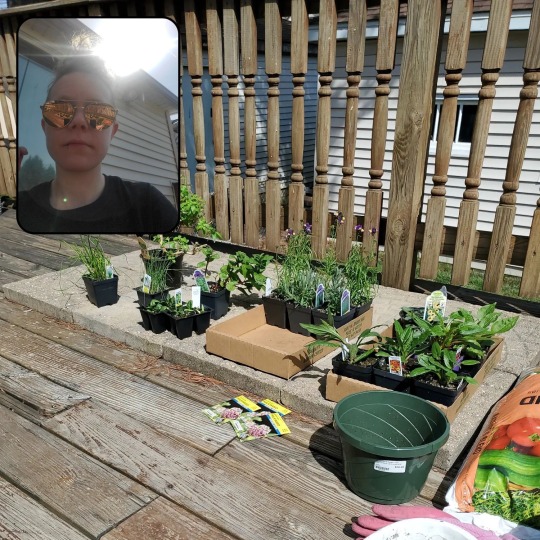
i was supposed to go to the garden center for fresh compost, which i did get! buuuut i also got some stuff to try out in pots on the back deck once it's consistently up around 50 at night here (they will live in our heated mudroom until then).
edible: chives, leeks, and spinach + lemon verbena, mint, and lavender for teas/drinks
then i also got some plants that are native to this region and good for local pollinators: black-eyed susans, milkweed, linaria, purple coneflower. i'm not expecting it all to live bc u always mess stuff up when ur first starting out but i'm excited to see what happens with it all! everything's a lesson even if it's not success :)
9 notes
·
View notes
Note
ehehehe.... unusual* steve opinion
*a thing you personally don't see enough of (whether in fic or conversation) that you enjoy or something you see TOO much of or something that no one seems to have on their radar but your third eye is open
Strap in, im procrastinating about eight different things and have Thoughts
-Classically trained musician Steve. incredibly, i love it. the more obscure the instrument the better
-Demisexual steve
-Hoh/deaf steve! not super uncommon i think but we always need more
Steve going into the medical field isnt super uncommon i think BUT i want him to be a Physical Therapist
-Steve is incredible at putting together Ikea/flatpack furniture. like scary good at it.
-Steve and Robin find a cute little house together and one day steve decides to go weed the old overgrown garden and he falls in love with gardening. a few months later they have the most gorgeous flower beds and pollinator gardens and he is working on getting rid of the turf grass they have and replace it with native grass/flowers/plants. they don't grow fruits and veggies though because neither of them can cook and he doesn't want to deal with christine at the farmers market who thinks her produce is the cats pajamas
-Art historian steve. yes im projecting. 5+1 coming soon to dashboards near you
-Steve looooves soap operas
-He almost always uses a cane
-He gets put on bed rest for a month or so and accidentally becomes a trekkie
-he gets like. really into buffy
-hes never seen the ocean and doesn't really have much of a desire to
-he is really sensitive to a lot of essential oils/scents and they tend to give him a brutal migraine
-he's really good at sewing and mending clothes and helps El when she wants to make a battle jacket. eventually he can't sew as well anymore bc of nerve damage so he teaches a few of the kids how to sew
-he happily punches nazis and homophobes
6 notes
·
View notes
Note
OUAT, crossover Ruby or Belle love interest?
Name:
Enchanted Forest: Indigo Robin
Storybrooke: Susan Marsh
Ship:
Angel Dearly Ruby Lucas & Roman Taylor
Facts:
She’s Cristopher Robin’s daughter
Was a maid in Dutchess Adelaide’s household, which is how she meets Roman.
In Storybrooke she’s a beekeeper but wants to be a writer.
On the repeating day would go to Granny’s to flirt with have a chance to see Ruby and Roman.
Her names come from three flowers that bees use to pollinate - White Wild Indigo, Black-Eyed Susan, and Marsh Blazing Star.

3 notes
·
View notes